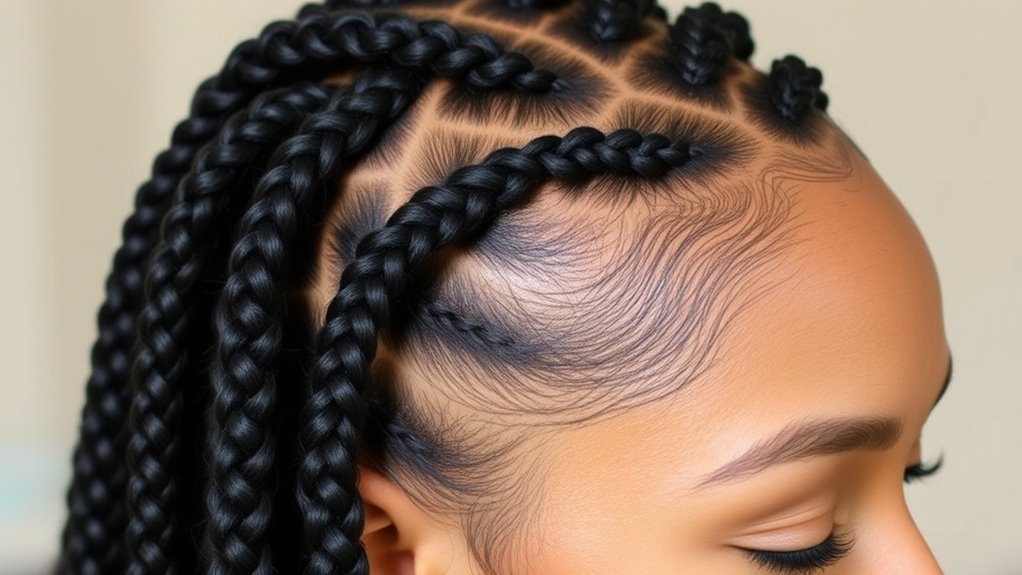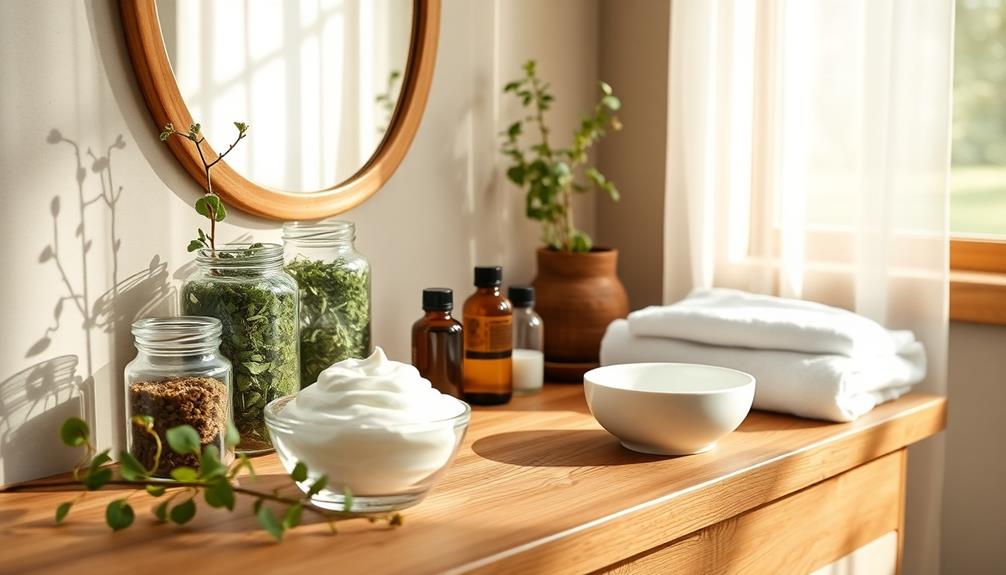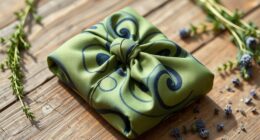To avoid damage with protective styles, don’t make styles too tight, as this strains your scalp and causes breakage. Keep your scalp clean and moisturized regularly, and avoid wearing styles for too long without giving your hair a break. Use gentle products suited to your hair type, and always loosen styles carefully with nourishing oils. Proper preparation and gradual removal protect your hair’s health—continue exploring expert tips to style safely and maintain your hair’s integrity.
Key Takeaways
- Ensure styles are not too tight to prevent scalp tension, discomfort, and traction alopecia.
- Limit protective style duration and incorporate regular rest periods for hair recovery.
- Use gentle detangling techniques, starting from ends and working upward, to avoid breakage.
- Maintain proper scalp hygiene with regular cleansing and moisturizing to prevent buildup and irritation.
- Carefully remove styles with nourishing oils and gentle detangling to preserve hair health and prevent damage.
Overly Tight Styles That Strain Your Hair and Scalp

While protective styles can give your hair a much-needed break, overly tight styles can do more harm than good. When you pull your hair too tightly, it increases scalp sensitivity, causing discomfort and potential inflammation. This tension also affects your hair’s elasticity, weakening the strands and making them more prone to breakage. Over time, tight styles can lead to traction alopecia, where hair is pulled out from the roots. If your scalp feels sore or tender after styling, it’s a clear sign you’ve gone too far. To protect your hair and scalp, choose styles that don’t pull excessively and give your scalp some relief between wears. Maintaining a gentle touch helps preserve your hair’s strength and elasticity, preventing long-term damage. Being aware of protective styles and their proper techniques can help you avoid these issues altogether.
Ignoring Proper Cleansing and Moisturizing Routines

Neglecting proper cleansing and moisturizing routines can quickly undermine your protective styles. Without regular hydration routines, your hair and scalp become dry and brittle, increasing breakage. It’s essential to keep your scalp clean to prevent buildup, itchiness, and irritation, which can lead to hair loss. Incorporate scalp exfoliation into your routine to remove dead skin cells and promote healthy growth. Proper cleansing prevents product buildup that can weigh down your styles and cause scalp issues. Follow up with deep moisturizing to lock in hydration and maintain elasticity. Skipping these steps makes your protective style less effective and can damage your hair in the long run. Consistent cleansing and moisturizing are key to keeping your hair healthy, strong, and looking its best while in protective styles.
Wearing Styles for Too Long Without a Break

Wearing protective styles for too long without giving your hair a break can cause significant damage over time. The length of style duration matters—keeping styles in for weeks without relief increases the risk of hair breakage. When you leave styles in too long, natural hair becomes weak and brittle, especially at the roots and edges. Your scalp also suffers from reduced airflow, which can lead to buildup and irritation. To prevent damage, it’s crucial to give your hair a rest period between styles. Removing protective styles after a few weeks allows your hair to recover, stay healthy, and reduce breakage. Paying attention to style duration helps maintain your hair’s strength and overall health, ensuring your protective efforts don’t backfire. Additionally, understanding the importance of cultural narratives promoted through haircare practices can help you make more informed styling decisions.
Neglecting Scalp Care and Hygiene

If you neglect your scalp care, dirt and oil can build up quickly, leading to irritation or breakouts. Keeping your scalp clean and moisturized helps maintain healthy hair growth and prevents issues down the line. Make sure to regularly refresh your scalp, even when wearing protective styles. Additionally, maintaining good scalp hygiene is essential to avoid common problems associated with neglect.
Keep Scalp Clean
Keeping your scalp clean is essential for maintaining healthy protective styles. When you neglect scalp hygiene, you’re more prone to scalp infections, which can cause discomfort and hair damage. Regular cleansing helps remove buildup from styling products, sweat, and dirt that can clog hair follicles. This reduces the risk of dandruff and promotes a healthier scalp environment. Use gentle shampoos suited for your hair type and avoid harsh chemicals that can irritate your skin. Keep your scalp dry and free from excess oil to prevent bacterial growth. Maintaining cleanliness also makes it easier to spot early signs of irritation or infections. Prioritizing scalp hygiene supports your overall hair health and foster positive father-daughter relationships, ensuring your hair stays strong and vibrant.
Moisturize Regularly
Neglecting to moisturize your scalp can lead to dryness, irritation, and flakiness, which compromise the health of your protective style. To prevent this, use effective hydration techniques like applying lightweight oils or water-based spritzes regularly. Moisturizer types vary; opt for leave-in conditioners, oil blends, or specially formulated scalp sprays designed for your hair type. These help lock in moisture, soothe irritation, and promote healthy hair growth. Incorporating proper scalp care into your routine can significantly improve overall hair health and prevent issues caused by dryness. Consistent hydration keeps your scalp supple and reduces buildup of dead skin cells. Remember, a well-moisturized scalp prevents itching and discomfort, ensuring your protective style lasts longer and remains healthy. Incorporate moisturizing routines into your weekly regimen, and your hair will stay nourished, vibrant, and protected.
Using the Wrong Products for Your Hair Type

Choosing the wrong products for your hair type can undermine your protective styling efforts and cause damage instead of offering the benefits you want. Understanding your hair porosity is key — whether your hair absorbs and retains moisture easily or needs more help. Using incompatible products, like heavy oils on low-porosity hair or lightweight formulas on high-porosity hair, can lead to buildup or dryness. Always check product compatibility with your hair’s unique needs. For example, if your hair is fine, avoid heavy creams that weigh it down; if it’s coarse or thick, opt for richer moisturizers. Using the right products tailored to your hair porosity ensures your protective styles stay healthy, moisturized, and damage-free. Don’t guess—know your hair and choose products that support its natural characteristics. Additionally, incorporating moisturizing techniques can help maintain optimal hair health and prevent issues caused by incorrect product use.
Applying Excessive Tension During Styling

Applying too much tension when styling can damage your hair and scalp. You might notice discomfort, headaches, or slower hair growth over time. It’s important to find a balance to protect your hair’s health and longevity. Additionally, using protective styling benefits can help minimize stress on your hair and prevent damage.
Tightness Causes Hair Damage
When you pull hair tightly during styling, you risk causing significant damage to your strands. Excessive tension creates hair breakage, especially around the edges and at the hairline, making your hair weaker over time. It also increases scalp tension, which can lead to discomfort and even hair loss if persistent. Tight styles can strain the roots, leading to thinning and permanent damage if left uncorrected. To prevent this, avoid pulling hair too tightly and opt for gentle, secure styles. Using loose braids or buns reduces stress on your scalp and preserves your hair’s health. Remember, maintaining a comfortable tension not only protects your strands but also keeps your scalp healthy, ensuring your protective styles serve their purpose without harm.
Discomfort and Headaches
Have you ever experienced a pounding headache or scalp discomfort after styling your hair tightly? This often happens when you apply excessive tension, which can increase scalp sensitivity and cause pain. Tight styles pull on your scalp, leading to headaches and lingering discomfort. To prevent this, avoid styling with too much force and opt for gentler techniques. Loosen up tight braids or ponytails to reduce tension, especially around your hairline. Practicing headache prevention means listening to your body—if you feel tightness or pain, loosen your style immediately. Protecting your scalp from unnecessary strain not only prevents discomfort but also supports healthier hair growth. Be mindful during styling, and prioritize comfort to avoid unnecessary headaches and scalp sensitivity. Additionally, choosing protective styles that do not tug on your edges can greatly reduce the risk of tension-related discomfort.
Reduced Hair Growth
Excessive tension during styling can considerably slow down hair growth and cause long-term damage. Many believe that tight styles promote growth, but this is a hair growth myth. In reality, pulling too tightly weakens hair follicles, leading to breakage and reduced growth over time. While protective style benefits include preventing damage and maintaining moisture, applying too much tension defeats these advantages. It’s essential to find a balance—secure styles without pulling excessively. Consistently tight styles can cause traction alopecia, a form of hair loss caused by stress on the scalp. To maximize protective style benefits and support healthy growth, opt for gentle, well-fitted styles that protect your hair without straining your scalp. Proper tension management is vital for avoiding damage, especially since scalp health plays a crucial role in hair growth. Your hair will thank you for it.
Forgetting to Detangle Gently and Carefully

Neglecting to detangle your hair gently and carefully can lead to unnecessary breakage and damage. When removing protective styles, it’s essential to prioritize gentle detangling to avoid stressing your strands. Use detangling tools designed for your hair type, such as wide-tooth combs or detangling brushes, to minimize breakage. Always work in small sections and start detangling from the ends, gradually working your way up to the roots. Avoid ripping through tangles or using excessive force, as this weakens your hair. Taking your time with gentle detangling preserves your hair’s health and prevents unnecessary damage. Remember, patience and proper tools are key to maintaining strong, healthy hair during the removal process.
Not Preparing Your Hair Properly Before Installing Styles

Before installing a protective style, taking the time to prepare your hair sets the foundation for a successful look and healthier strands. Proper product selection is essential to guarantee your hair stays moisturized and resilient during styling. Use hydrating products like leave-in conditioners or oils to boost moisture levels and prevent dryness. Adequate hair hydration helps reduce breakage and makes your strands more pliable, easing the styling process. Before installing, detangle gently to avoid unnecessary damage, and verify your hair is clean and free of product buildup. Skipping these steps can lead to increased breakage or scalp irritation once the style is in place. Proper preparation not only enhances the longevity of your protective style but also supports overall hair health. Additionally, understanding the importance of protective styling can help you make informed choices for maintaining healthy hair.
Failing to Remove Styles Correctly to Prevent Breakage

Removing a protective style improperly can cause significant damage to your hair. To prevent breakage, proper removal is essential. Here’s how you can do it right:
- Gently loosen the style by applying a nourishing oil or conditioner to weaken the bonds, making removal easier.
- Carefully unravel or loosen the style, avoiding aggressive pulling to prevent unnecessary tension.
- Once removed, detangle your hair gently with a wide-tooth comb, working from ends to roots to minimize breakage.
Skipping these steps risks damaging your strands and undoing the protective benefits. Proper removal helps maintain hair health and length. Take your time, be gentle, and prioritize your hair’s integrity to avoid unnecessary breakage and keep your hair strong and healthy.
Frequently Asked Questions
How Do I Know if My Protective Style Is Too Tight?
You’ll know your protective style is too tight if you experience hairline tension or scalp discomfort. If your edges feel pulled or sore, it’s a clear sign to loosen up. You shouldn’t feel constant pain or tightness that causes pulling or aching. Pay attention to how your scalp feels—if it’s tender or sore, loosen the style immediately to prevent damage. Your comfort and scalp health should always come first.
What Are Signs of Scalp Irritation From Protective Styles?
Your scalp’s crying out for help when you notice itching, redness, and swelling. These signs indicate irritation from your protective style. It’s like a red flag waving — you should loosen the style, gently massage your scalp, and avoid scratching. If symptoms persist, remove the style and see a dermatologist. Protect your scalp’s health by paying attention to these signals and giving it time to breathe.
How Often Should I Give My Hair a Break From Styles?
You should give your hair a break from protective styles every 2 to 4 weeks to promote healthy hair growth and prevent damage. Sticking to a consistent styling frequency allows your scalp to breathe and reduces the risk of irritation. During these breaks, focus on deep conditioning and scalp care to maintain your hair’s health. Balancing styling time with rest helps make certain your hair stays strong and vibrant.
Which Products Are Best for My Specific Hair Type?
You should choose products based on your hair compatibility and specific needs. Look for gentle, sulfate-free shampoos, moisturizing conditioners, and lightweight oils that suit your hair type—whether curly, straight, or textured. Product selection is key, so read labels carefully and avoid ingredients that may cause buildup or damage. Using the right products helps maintain healthy hair and prevents issues like dryness or breakage during protective styling.
How Can I Safely Remove Protective Styles Without Damage?
Ever thought removing a protective style is like ripping off a Band-Aid? Instead, opt for gentle removal by carefully detangling and loosening the style. Use soft, nourishing products to aid in slipping out each section without damage. Select the right products for your hair type, and take your time. Patience and gentle techniques turn what feels like a chore into a stress-free process that keeps your hair healthy and happy.
Conclusion
Think of your hair like a delicate garden; neglecting proper care and rushing through styles can cause damage and setbacks. I once saw a client try to keep a style for months without breaks, and her hair suffered. Protecting your strands means tending to them gently, just like watering and pruning a garden. Stay mindful of these pitfalls, and your hair will flourish beautifully—strong, healthy, and vibrant for years to come.










